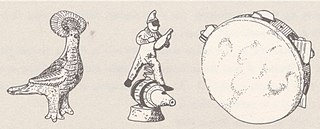
The tambourine is a musical instrument in the percussion family consisting of a frame, often of wood or plastic, with pairs of small metal jingles, called "zills". Classically the term tambourine denotes an instrument with a drumhead, though some variants may not have a head. Tambourines are often used with regular percussion sets. They can be mounted, for example on a stand as part of a drum kit, or they can be held in the hand and played by tapping, hitting, or shaking the instrument.

Tarantism is a form of hysteric behaviour originating in Southern Italy, popularly believed to result from the bite of the wolf spider Lycosa tarantula. A better candidate cause is Latrodectus tredecimguttatus, commonly known as the Mediterranean black widow or steppe spider, although no link between such bites and the behaviour of tarantism has ever been demonstrated. However, the term historically is used to refer to a dancing mania – characteristic of Southern Italy – which likely had little to do with spider bites. The tarantella dance supposedly evolved from a therapy for tarantism.
Tarantella is a group of various southern Italian folk dances originating in the regions of Calabria, Campania and Puglia. It is characterized by a fast upbeat tempo, usually in 6
8 time, accompanied by tambourines. It is among the most recognized forms of traditional southern Italian music. The specific dance-name varies with every region, for instance Sonu a ballu in Calabria, tammurriata in Campania, and pizzica in Salento. Tarantella is popular in Southern Italy, Greece, Malta, and Argentina. The term may appear as tarantello in a linguistically masculine construction.

Carpino is a coastal town and comune of the Italian region of Apulia, lying on the Gargano peninsula.
A patronal feast or patronal festival is a yearly celebration dedicated – in countries influenced by Christianity – to the 'heavenly advocate' or 'patron' of the location holding the festival, who is a saint or virgin. The day of this celebration is called patronal feast day, patronal day or patron day of said location.

Glen Velez is a four-time Grammy winning American percussionist, vocalist, and composer, specializing in frame drums from around the world. He is largely responsible for the increasing popularity of frame drums in the United States and around the world. Velez is married to Loire.

Fellini's Casanova is a 1976 Italian surrealist erotic historical drama film directed by Federico Fellini from a screenplay he co-wrote with Bernardino Zapponi, adapted from the autobiography of 18th-century Venetian adventurer and writer Giacomo Casanova, portrayed by Donald Sutherland. The film depicts Casanova's life as a journey into sexual abandonment, and his relationship with the "love of his life" Henriette. The narrative presents Casanova's adventures in a detached, methodical fashion, as the respect for which he yearns is constantly undermined by his more basic urges.

Italian folk music has a deep and complex history. National unification came quite late to the Italian peninsula, so its many hundreds of separate cultures remained un-homogenized until quite recently. Moreover, Italian folk music reflects Italy's geographic position at the south of Europe and in the center of the Mediterranean Sea: Celtic, Slavic, Arabic, Greek, Spanish and Byzantine influences are readily apparent in the musical styles of the Italian regions. Italy's rough geography and the historic dominance of small city states has allowed quite diverse musical styles to coexist in close proximity.
The music of Apulia has had some glorious history as well as some very hard times. Located along the southern Adriatic, the area was part of Magna Grecia and certainly one of the centers of Ancient Greek music. And 1,000 years ago, Bari, on the coast, was a privileged sanctuary for pilgrims and Crusaders on their way to the Holy Land. Yet, the only musical relic that remains from the period is the Excultet, a representation from the 11th century of two angels playing trumpets that is preserved in the Basilica of San Nicola in Bari. Later, as part of the Kingdom of Naples, Apulia produced many memorable names in music, but like elsewhere in the south, many of them gravitated to Naples, the capital of the kingdom.
Italian music terminology consists of words and phrases used in the discussion of the music of Italy. Some Italian music terms are derived from the common Italian language. Others come from Spanish, or Neapolitan, Sicilian, Sardinian or other regional languages of Italy. The terms listed here describe a genre, song form, dance, instrument, style, quality of music, technique or other important aspect of Italian music.

Pizzica is a popular Italian folk dance, originally from the Salento peninsula in Apulia and later spreading throughout the rest of Apulia and the regions of Calabria and eastern Basilicata.
John La Barbera is an American musical composer and arranger. He currently teaches at the Bergen Community College in Paramus, New Jersey, and has written for Acoustic Guitar magazine.

Italian folk dance has been an integral part of Italian culture for centuries. Dance has been a continuous thread in Italian life from Dante through the Renaissance, the advent of the tarantella in Southern Italy, and the modern revivals of folk music and dance.

Alessandra Carina Mastronardi is an Italian actress. She is best known for her roles in the films To Rome with Love and The Unbearable Weight of Massive Talent, and the television series Master of None, for which she garnered a nomination for the Critics' Choice Television Award for Best Supporting Actress in a Comedy Series in 2017.

The Ghironda is the International Festival of Arts and Popular Culture of the Five Continents. It was established in 1995 in Martina Franca, with the intention of attracting the attention of the public and tourists to the historical sites of the southern Italian region of Apulia and to facilitate exchanges of music, art and culture from around the world.
Greek musical instruments were grouped under the general term "all developments from the original construction of a tortoise shell with two branching horns, having also a cross piece to which the stringser from an original three to ten or even more in the later period, like the Byzantine era". Greek musical instruments can be classified into the following categories:

In ancient Greece and Rome, the tympanon (τύμπανον) or tympanum, was a type of frame drum or tambourine. It was circular, shallow, and beaten with the palm of the hand or a stick. Some representations show decorations or zill-like objects around the rim. The instrument was played by worshippers in the rites of Dionysus, Cybele, and Sabazius.

Folklore of Italy refers to the folklore and urban legends of Italy. Within the Italian territory, various peoples have followed one another over time, each of which has left its mark on current culture. Some tales also come from Christianization, especially those concerning demons, which are sometimes recognized by Christian demonology. Italian folklore also includes the genre of the fairy tale, folk music, folk dance and folk heroes.
"Devil Pray" is a song recorded by American singer and songwriter Madonna for her thirteenth studio album, Rebel Heart (2015). It was written and produced by Madonna, Avicii, DJ Dahi, and Michael Diamond (BloodPop), with additional writing by Arash Pournouri, Carl Falk, Rami Yacoub, and Savan Kotecha. During the early stages of the album, Madonna was encouraged by her manager to work with Avicii and his team of songwriters. Together, they worked on seven songs and "Devil Pray" was composed after Madonna desired to talk about her experiences with drugs and quest for spirituality. Lyrically, the song deals with themes of drug addiction, sin, temptation, and the desire for salvation.
Tarantolati di Tricarico are a group of Lucanian folk music.












